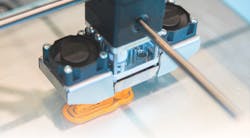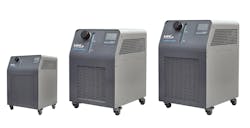Heat Transfer a Cool Concept
Using liquids for heat transfer is an important cooling method for many applications to maximize performance and operational life for thermally sensitive electronics and systems. As next generation systems feature more functionality in smaller, more compact form factors, precise temperature control has become more critical.
Compressor-based recirculating chiller systems can dissipate a large amount of heat in densely packed electronic enclosures to facilitate more complex system designs. Modern recirculating chillers combine a high capacity for efficiently transferring waste heat compared to other cooling technologies—all with lower noise and less maintenance.
In addition to cooling performance demands, today’s compressor-based recirculating chillers must adhere to strict industry requirements, as well as government restrictions on the use of ozone depleting and high global warming refrigerants.
Comparing Technologies
Compressor-based liquid cooling systems are self-contained units that recirculate coolant to a predefined temperature setpoint. Standard and custom liquid cooling systems are able to dissipate the large amount of heat generated in densely packed electronic environments to ensure optimal thermal stabilization and precise temperature control.
Compressor-based refrigeration systems offer a high coefficient of performance (COP). If they are cooling a heat load of 3kW, they only require 1kW of energy to do the cooling work. Compressor-based systems tend to be smaller than alternative technologies like liquid-to-air heat exchangers when achieving setpoints near ambient temperatures because they make use of the refrigerant’s latent energy to increase heat exchanger efficiency. Thermoelectric devices are smaller, but they are less efficient at cooling heat loads above 500W.
Central facility cooling systems are another option. However, these systems are used to cool all of the equipment in the entire building. It can be difficult for a single central facility cooling system to maintain precise thermal control and satisfy an equipment’s specific cooling requirements. In addition, it cannot guarantee a constant temperature and flow rate.
Cooling Industrial Lasers
Efficiently cooling lasers can be a significant challenge, as different laser technologies have different requirements. For example, fiber lasers have better cooling characteristics over other media due to their specific arrangement, which enables them to spread the heat over a larger surface area. Ion lasers are characterized by the generation of extreme heat, and thus need elaborate cooling measures.
Carbon dioxide lasers emit heat energy in the far-infrared and microwave region of the spectrum. To ensure proper, long-term performance of the laser, cooling systems need to be tailored to the industrial laser application to efficiently dissipate heat.
Depending on the laser type, system size and configuration, many kilowatts of heat can be generated from the laser. For laser systems that generate heat in excess of a few hundred watts, a liquid coolant solution is warranted. For optimal performance, the laser optics typically require a stable operating temperature of 20°C ± 0.1°C, while ambient temperature may fluctuate between 23°C to 35°C in the operating environment. Waste heat may be transferred by a coolant or directly to air. Coolant is circulated through a chiller or heat transfer system to pump heat away from sensitive laser components and maintain a constant operating temperature.
Some cooling solutions feature pumps with greater pulsation. Pulsating pumps still offer the required system cooling but create vibration within the cooling system. In laser systems, this has similar effects to thermal instability and results in a less focused laser beam and lower quality performance, which is critical in cutting and engraving applications.
Industrial lasers are commonly used for cutting hard materials like steel. The laser beam melts through whatever material it is focused on. When cooled efficiently, the laser beam creates a finer, more precise cut or engraving. If the laser beam operates outside the optimum temperature range, it is not as focused and creates a rougher, less precise cut or engraving.
Additive Manufacturing
Additive manufacturing is a process that creates a desired object by stacking (printing) layer after layer of melted plastic resin or metal to create a solid three-dimensional part. Products of complex design can now be easily conceptualized and manufactured with great precision by additive manufacturing. As a result, a wide range of industries are now implementing additive manufacturing technologies. The medical industry is using 3D printing to make casts, prostheses, hip replacements and more. The aerospace and automotive industries use 3D printing to make new and retrofit lightweight parts. General manufacturing and consumer goods market also are increasing use of additive manufacturing methods.
Powder bed 3D printers use a laser beam, electron beam, or a thermal heated printhead to melt plastic resin or metal material that is immediately laid down, layer by layer, on a printing bed until the 3D object is completed. To optimize 3D printing performance, the laser- and electron-beam optics must be efficiently cooled. Precise cooling is also needed to help control the viscosity of the liquid powder as it is dispensed onto the surface of the thermal printhead.
Depending on the material that is being used for printing, heat generated from the laser or electron beam can be many kilowatts. As mentioned before, the laser optics typically require a stable operating temperature of 20°C ± 0.1°C, while ambient temperature may fluctuate between 23°C to 35°C in the operating environment. Laser-beam and electron-beam power supplies often need to be cooled as well, as overheating degrades the reliability and operating lifetime.
Laboratory Equipment
Properly cooling an analytic instrument like an electron microscope requires a sophisticated thermal management system. Modern electron microscopes produce electron micrographs using specialized digital cameras and frame grabbers to capture the images. Electron microscopes use a high voltage electron beam to illuminate a specimen and create an image. The electron beam is produced by an electron gun. Depending on the type of electron microscope, the beam is sent through a combination of lenses and apertures, the specimen sample being analyzed, and a viewing screen where the camera is mounted to take the image.
The electron beam can be controlled or manipulated via a magnetic field according to the left hand rule. Electromagnets create a magnetic field that allows for the formation of a magnetic lens of variable focusing power.
The coils that produce the magnetic field are located within the lens yoke. The coils can contain a variable current but typically use high voltages and require significant insulation in order to prevent short-circuiting the lens components. These coil windings require a thermal management solution to remove the heat generated when creating the magnetic field.
Application Challenges
Whether in an industrial environment or a laboratory setting, many challenges exist in terms of the design, implementation and maintenance of liquid cooling systems. Precise temperature stability is vital for applications that utilize recirculating chillers, such as the Nextreme Recirculating Chiller Platform from Laird Thermal Systems, as is robustness and maintenance-free operation to ensure maximum system uptime.
Loud, vibrating machines can create an unpleasant and dangerous work environment. Equipment cooling units can play a significant role in the decibel level of a manufacturing or laboratory setting. Some equipment, like electron microscopes, are sensitive to shock, vibration and other disturbances in the surrounding environment. Some liquid pump models cause more vibration as a result of higher pulsations in the fluid lines. This is the case with a rotary vane pump or centrifugal pump. Turbine pumps have significantly less pulsation, which results in better imaging by the microscope.
Equipment designs must also take airflow into account. Paths for incoming and exhaust air must be considered to maximize the cooling performance.
Many applications must also take condensation protection into account. Moisture forms on cold surfaces as temperature drops below the dew point. If this moisture seeps into the electronics, it can cause deterioration and ultimately failure of the electronics. Using properly designed insulation materials can provide a cooling solution resistant to moisture intrusion.
Many governments also continue to develop strict environmental legislation aimed at curbing climate change, which restricts usage of refrigerants in several refrigeration and freezer systems. The phase down on environmentally harmful refrigerants, like HFC refrigerants including R134a and R404A, has led to the development of new, eco-friendly refrigeration systems. These systems use natural refrigerants that have a reduced eco-footprint.
However, the flammable nature of some natural refrigerants can make them hazardous to transport, and each one presents design challenges such as increased operating pressure, high toxicity, flammability, asphyxiation and relatively poor performance. Another restriction in Europe is ROHS (Reduction of Hazardous Substance), which prohibits the use of lead, mercury, cadmium and other heavy metals in electronic products.
The trend of increasing power densities with decreasing form factor requirements continues to make precise thermal management challenging. However, today’s compressors are more efficient than a decade ago. Compact chiller systems offer a higher coefficient of performance that delivers efficient, low-power consumption to maximize uptime and optimize performance in a wide range of applications.
Greg Ducharme is a product director for Laird Thermal Systems.


